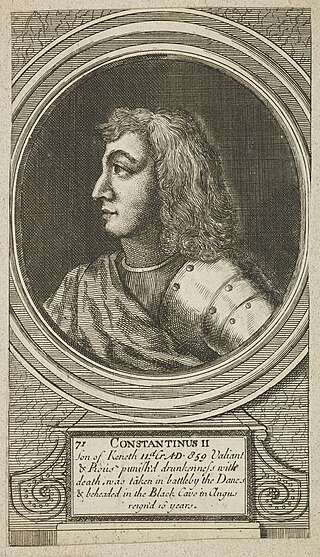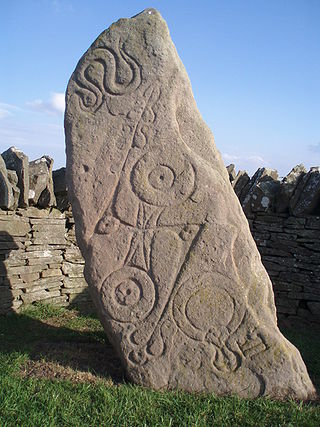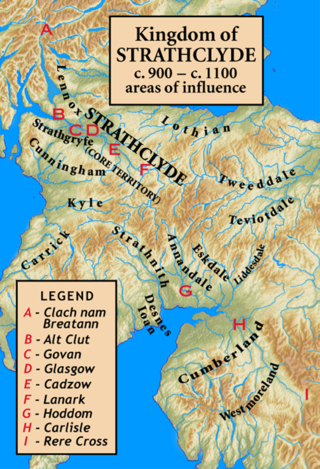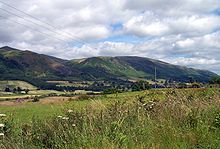
Causantín mac Cináeda was a king of the Picts. He is often known as Constantine I in reference to his place in modern lists of Scottish monarchs, but contemporary sources described Causantín only as a Pictish king. A son of Cináed mac Ailpín, he succeeded his uncle Domnall mac Ailpín as Pictish king following the latter's death on 13 April 862. It is likely that Causantín's reign witnessed increased activity by Vikings, based in Ireland, Northumbria and northern Britain. He died fighting one such invasion.

Causantín mac Áeda was an early King of Scotland, known then by the Gaelic name Alba. The Kingdom of Alba, a name which first appears in Constantine's lifetime, was situated in modern-day Northern Scotland.
Kenneth MacAlpin or Kenneth I was King of Dál Riada (841–850), and King of the Picts (843–858) of likely Gaelic origin. He inherited the throne of Dál Riada from his father Alpín mac Echdach, founder of the Alpínid dynasty. Kenneth I conquered the kingdom of the Picts in 843–850 and began a campaign to seize all of Scotland and assimilate the Picts, for which he was posthumously nicknamed An Ferbasach. He fought the Britons of the Kingdom of Strathclyde and the invading Vikings from Scandinavia. Forteviot became the capital of his kingdom and Kenneth relocated relics, including the Stone of Scone from an abandoned abbey on Iona, to his new domain.

The Picts were a group of peoples in what is now Scotland north of the Firth of Forth, in the Early Middle Ages. Where they lived and details of their culture can be gleaned from early medieval texts and Pictish stones. The name Picti appears in written records as an exonym from the late third century AD. They are assumed to have been descendants of the Caledonii and other northern Iron Age tribes. Their territory is referred to as "Pictland" by modern historians. Initially made up of several chiefdoms, it came to be dominated by the Pictish kingdom of Fortriu from the seventh century. During this Verturian hegemony, Picti was adopted as an endonym. This lasted around 160 years until the Pictish kingdom merged with that of Dál Riata to form the Kingdom of Alba, ruled by the House of Alpin. The concept of "Pictish kingship" continued for a few decades until it was abandoned during the reign of Caustantín mac Áeda.
The 870s decade ran from January 1, 870, to December 31, 879.

Year 878 (DCCCLXXVIII) was a common year starting on Wednesday of the Julian calendar.

Strathclyde was a Brittonic kingdom in northern Britain during the Middle Ages. It comprised parts of what is now southern Scotland and North West England, a region the Welsh tribes referred to as Yr Hen Ogledd. At its greatest extent in the 10th century, it stretched from Loch Lomond to the River Eamont at Penrith. Strathclyde seems to have been annexed by the Goidelic-speaking Kingdom of Alba in the 11th century, becoming part of the emerging Kingdom of Scotland.

Eochaid ab Rhun was a ninth-century King of Strathclyde, who may have also been King of the Picts. He was a son of Rhun ab Arthgal, King of Strathclyde, and descended from a long line of British kings. Eochaid's mother is recorded to have been a daughter of Cináed mac Ailpín, King of the Picts. This maternal descent from the royal Alpínid dynasty may well account for the record of Eochaid reigning over the Pictish realm after the death of Cináed's son, Áed, in 878. According to various sources, Áed was slain by Giric, whose ancestry is uncertain and who then proceeded to usurp the Alban throne.

Scandinavian York or Viking York is a term used by historians for what is now Yorkshire during the period of Scandinavian domination from late 9th century until it was annexed and integrated into England after the Norman Conquest; in particular, it is used to refer to York, the city controlled by these kings and earls. The Kingdom of Jórvíc was closely associated with the much longer-lived Kingdom of Dublin throughout this period.
The House of Alpin, also known as the Alpínid dynasty, Clann Chináeda, and Clann Chinaeda meic Ailpín, was the kin-group which ruled in Pictland, possibly Dál Riata, and then the kingdom of Alba from the advent of Kenneth MacAlpin in the 840s until the death of Malcolm II in 1034.

Halfdan Ragnarsson was a Viking leader and a commander of the Great Heathen Army which invaded the Anglo-Saxon kingdoms of England, starting in 865.

The Great Heathen Army, also known as the Viking Great Army, was a coalition of Scandinavian warriors who invaded England in AD 865. Since the late 8th century, the Vikings had been engaging in raids on centres of wealth, such as monasteries. The Great Heathen Army was much larger and aimed to conquer and occupy the four kingdoms of East Anglia, Northumbria, Mercia and Wessex.

Rhun ab Arthgal was a ninth-century King of Strathclyde. He is the only known son of Arthgal ap Dyfnwal, King of Alt Clut. In 870, during the latter's reign, the fortress of Alt Clut was captured by Vikings, after which Arthgal and his family may have been amongst the mass of prisoners taken back to Ireland. Two years later Arthgal is recorded to have been slain at the behest of Causantín mac Cináeda, King of the Picts. The circumstances surrounding this regicide are unknown. The fact that Rhun seems to have been Causantín's brother-in-law could account for Causantín's interference in the kingship of Alt Clut.
Ricsige was King of Northumbria from 873 to 876. He became king after Ecgberht I was overthrown and fled, with Wulfhere, Archbishop of York, to Mercia.
Amlaíb Conung was a Viking leader in Ireland and Scotland in the mid-late ninth century. He was the son of the king of Lochlann, identified in the non-contemporary Fragmentary Annals of Ireland as Gofraid, and brother of Auisle and Ímar, the latter of whom founded the Uí Ímair dynasty, and whose descendants would go on to dominate the Irish Sea region for several centuries. Another Viking leader, Halfdan Ragnarsson, is considered by some scholars to be another brother. The Irish Annals title Amlaíb, Ímar and Auisle "kings of the foreigners". Modern scholars use the title "kings of Dublin" after the Viking settlement which formed the base of their power. The epithet "Conung" is derived from the Old Norse konungr and simply means "king". Some scholars consider Amlaíb to be identical to Olaf the White, a Viking sea-king who features in the Landnámabók and other Icelandic sagas.
Events from the 9th century in England.
Events from the 9th century in Ireland.
The Battle of Strangford Lough was fought in 877 between two groups of rival Vikings described by the Irish Annals as the "fair heathens" and the "dark heathens". The Annals of Ulster describe "Albann", a figure usually identified with Halfdan Ragnarsson, a leader of the Great Heathen Army, as king of the "dark heathens", and Cogad Gáedel re Gallaib identifies Bárid mac Ímair, King of Dublin as the leader of the "fair heathens". All accounts agree Halfdan was killed in the battle, and Cogad Gáedel re Gallaib adds that Bárid was wounded in it.

The siege of Dumbarton was a successful four-month siege of the Brittonic fortress at Dumbarton Rock in 870, initiated by the Viking leaders Amlaíb, King of Dublin, and Ímar. Dumbarton was capital of the Kingdom of Alt Clut, the only surviving Brittonic kingdom outside of Wales. It represented a valuable target for the Viking invaders, who were likely motivated by strategic considerations, as well as loot. The attackers may have wished to remove Alt Clut as a maritime power, and the location and defensiveness of Dumbarton itself was of major value.
The Battle of York was fought between the Vikings of the Great Heathen Army and the Anglo-Saxon Kingdom of Northumbria on 21 March 867 in the city of York.














